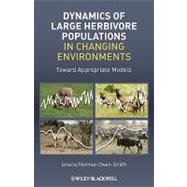
Note: Supplemental materials are not guaranteed with Rental or Used book purchases.
Purchase Benefits
Looking to rent a book? Rent Dynamics of Large Herbivore Populations in Changing Environments Towards Appropriate Models [ISBN: 9781405198943] for the semester, quarter, and short term or search our site for other textbooks by Owen-Smith, Norman. Renting a textbook can save you up to 90% from the cost of buying.
| Contributors | |
| Preface | |
| Definitive case studies | |
| Red deer on Rum | |
| Soay sheep on Hirta | |
| Roe deer in France | |
| Bighorn sheep in Alberta | |
| Kudu in Kruger | |
| Wildebeest in Serengeti | |
| Moose on Isle Royale | |
| Elk in North Yellowstone | |
| Overview | |
| Acknowledgments | |
| References | |
| The suite of population models | |
| Models of density dependence | |
| Autoregressive time-series models | |
| Age- or stage-structured models | |
| Trophic interaction models | |
| Physiological or metaphysiological models | |
| Models accommodating spatial structure | |
| Individual-based models | |
| Overview | |
| Acknowledgments | |
| References | |
| Climatic influences: temperate tropical contrasts | |
| Temperate environments | |
| Tropical and subtropical environments | |
| Effects of predation and hunting | |
| Overall assessment | |
| Acknowledgments | |
| References | |
| Demographic processes: lessons from long-term, individual-based studies | |
| Life history of large herbivores: a brief review | |
| Differential contributions of demographic parameters to population growth | |
| Climatic variation, density-dependence,andindividual variability | |
| Conclusions:howcanfutureanalysesof largeherbivoredemography deal with complex demographic processes? | |
| Acknowledgments | |
| References | |
| Irruptive dynamics and vegetation interactions | |
| Models of herbivore vegetation interactions | |
| Examples of irruptive dynamics | |
| Effects of irruptions on vegetation | |
| Changing perspectives | |
| Synthesis | |
| Implications for conservation and management | |
| Acknowledgments | |
| References | |
| How does landscape heterogeneity shape dynamics of large herbivore populations? | |
| What is spatial heterogeneity? | |
| How does spatial heterogeneity influence ungulate population dynamics? | |
| Mechanisms explaining the influence of spatial heterogeneity on population dynamics | |
| Influences from high-quality resources | |
| Influences from buffer resources | |
| Global change and access to heterogeneity by large herbivores | |
| Conclusions: the importance of spatial context for population dynamics | |
| Acknowledgments | |
| References | |
| Towards an ecology of population dynamics | |
| Phenomenological descriptors | |
| Time series elaborations | |
| Environmental structure | |
| Population structure | |
| Adaptive responses and environmental contexts | |
| Summary and conclusions | |
| Acknowledgments | |
| References | |
| Index | |
| Table of Contents provided by Publisher. All Rights Reserved. |
The New copy of this book will include any supplemental materials advertised. Please check the title of the book to determine if it should include any access cards, study guides, lab manuals, CDs, etc.
The Used, Rental and eBook copies of this book are not guaranteed to include any supplemental materials. Typically, only the book itself is included. This is true even if the title states it includes any access cards, study guides, lab manuals, CDs, etc.